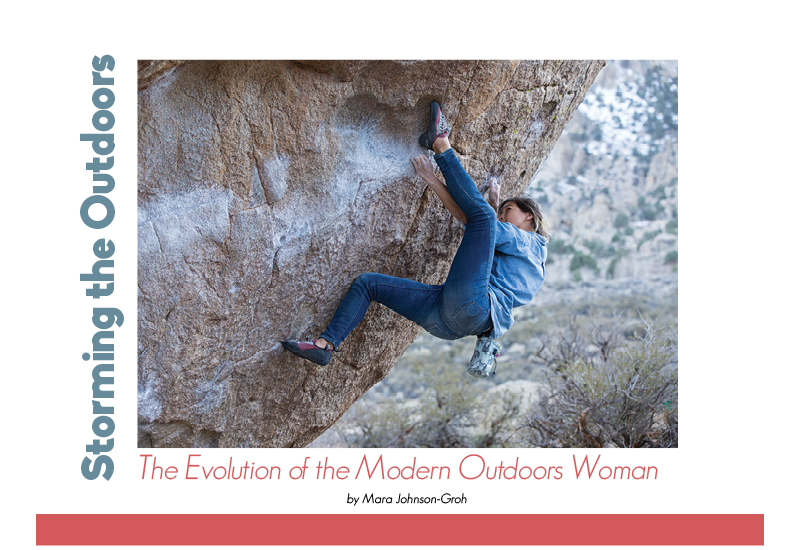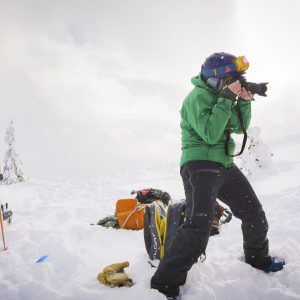It’s a good time to be a woman. Women are breaking ceilings, opening dialogues and working to eliminate inequalities across the board.
A movement similar to some pioneered in the 1960s is currently afoot in the outdoor arena. The last few years in particular have delivered a sweeping avalanche of change in the modern outdoors woman’s identity. Women are storming the outdoors, a sphere too long deemed in Western culture as a “man’s place,” and they’re not asking permission to do so.
“The perception of who participates in outdoor activities is no longer just a ‛25-to-35-year-old white male.’ We are all ages, genders, races, social classes and occupations,” says Julie Ellison, devoted climber and the first female Editor-in-Chief of Climbing Magazine.
Tired of being sidelined and ignored, female leaders and influencers are spearheading campaigns and conversations, challenging old notions about what women can and can’t do outside. While many positive changes have already occurred—like the progression of women’s gear from nonexistent to pink and flowery—before landing on today’s options for technical gear, women still find inequalities in the outdoors. One of the most discussed remaining issues for women is the problem with representative imagery.
“I think photography is really powerful because it shows instead of tells,” says Lisa Slagle, Founder and CEO of Wheelie Creative, an agency focused on featuring women both on-screen and behind the lens. “When you have a camera in your hands, you show people what you see.”
And what we’ve typically seen, Slagle says, is the viewpoint created by male action sports photographers who produce 80% of the industry content. For example, women bikers, when they’re even shown, are often featured standing next to their bikes, instead of riding them in action shots as men are typically portrayed.
Slagle isn’t alone in pushing for better women’s representation. Lynsey Dyer, a professional skier, set out to create a ski movie featuring aspects of the community traditionally left out of adventure films. She ended up with Pretty Faces, a blockbuster success in 2014 that highlighted female athletes. Similarly, the Never Not Collective, a female-run production company, is working on the first feature-length climbing film exclusively produced by and starring women.
“There are so many incredible women doing so many incredible things, but we don’t see them reflected in films,” Dyer says. “I wanted to give young girls better role models and expose them to these amazing women that do exist. We just don’t see them promoted.”
In addition to reshaping the narrative through images, women are raising their voices to advocate and share their own experiences. Diverse storytelling is a cornerstone of Gale Straub’s website and podcast, She Explores, created to elevate women’s voices and visuals in the outdoors. Straub strives to create depth and narrative in her work to engage women with the outdoors as well as each other.
“As women, we are going to tell different stories and offer alternative perspectives to what a man might show,” says Ellison, one of the creative minds behind Never Not Collective. “We’re really ready to tell stories that have otherwise been overlooked.”
A desire for storytelling, especially from perspectives that have been underrepresented, is widely craved as images are becoming increasingly inauthentic, where models often replace athletes and Instagram scenes are carefully posed. Many women have become frustrated as their very identities are now targeted as a marketing ploy by companies hoping to turn a profit.
“It’s hilarious it’s been labeled as ‛that whole women’s thing,’” Slagle says. “It’s not a thing, it’s our life.”
Indeed, for some, simply defining the “outdoors woman” identity can be confining. “Even talking about women can be limiting for people who are more gender fluid,” notes Straub. The transformation of the modern outdoors woman in the end is not just about women or people who don’t identify as male.
“It’s important that we involve all voices in this work. To exclude anyone is to limit the progress that we are capable of,” says Teresa Baker. “I think men play a vital role in pushing women forward… having them be faces that are up front, making decisions for the outdoor industry companies as a whole.”
While mixed-gender support is necessary, the current driving force of change is women encouraging women. Most of today’s female leaders honed their skills in the outdoors as the sole woman in a group of men, which often created a competitive atmosphere. Now, women in all outdoors disciplines are stepping up to give back, helping to inspire and educate others in a more inclusive environment.
“I think that it’s important that women are teaching women. It reinforces that we can be experts, that we can be decision makers, that we can be leaders,” says Shelma Jun, Founder of the Women’s Climbing Festival and Flash Foxy, an online women’s climbing community. “When we support each other, we’re stronger together. And it’s more fun.”
This tone of collaboration heralds a promising outlook for the future of the outdoors woman, which will undoubtedly continue to rapidly evolve in the next few years. Women in all areas are tackling issues on their own terms and creating solutions. While females have historically been portrayed as the weaker sex and unfit for the outdoors, these women leaders have shown there is no evidence to support that claim.
“In the past, we’ve felt like we’re just waiting for an invitation,” Dyer says. “My message is to stop waiting for an invitation…our job in being on the planet is to create where we see things missing, not to be angry at someone else for not creating it.”
Having developed their skills and crafts in an often isolated and male-dominated culture, women in the outdoors are ready to give back and inspire the next wave of feminine outdoor enthusiasts. These organizations and nonprofits are just a small sampling of ways women are coming together to create a supportive outdoors community.
She Jumps
The nonprofit She Jumps, co-founded by Lynsey Dyer, works to increase female participation in the outdoors through youth initiatives, outdoor education programs, ski mountaineering courses, grassroots gatherings and more. www.shejumps.org
Wheelhouse Workshops
Lisa Slagle is working to get cameras into the hands of more women with a series of photography workshops aimed at helping women learn tricks of the trade, like how to shoot in difficult lighting, work with pros and train for strenuous photo shoots in the mountains. www.wheelhouseworkshops.com
Women’s Climbing Festival
To provide a space for “camaraderie, conversation, connection and climbing,” Shelma Jun started the Women’s Climbing Festival in 2016. The event, which started as a small, tentative undertaking, has garnered immense success and expanded to two festivals annually. www.flashfoxy.com/wcf
She Explores
The brainchild of Gale Straub, She Explores is a website and podcast for creative and inquisitive outdoors women, and has featured hundreds of women’s stories and art. The site recently launched a spin-off podcast, Women on the Road, with interviews of women in various stages of life on the road. www.she-explores.com
Hike Like a Woman
In 2014, Rebecca Walsh set out to create an inclusive online space for women of all ages, shapes, ethnicities and sexualities. She launched the Hike Like a Woman website, which has since expanded into a podcast, magazine and online courses, providing a home to a growing community of women inspiring women, on and off trail. www.hikelikeawoman.net
Images by courtesy of Wheelie Creative and Colette McInerney.
xx Mara Johnson-Groh
This article was originally published in RANGE Magazine Issue Eight.


